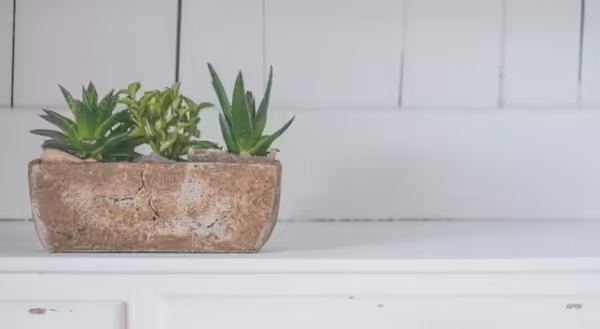
The kitchen is often the heart of every home. Whether it is time spent there preparing a family-favorite recipe, sitting around the table with loved ones, or resting at the counter as you enjoy a hot cup of coffee and read the morning news, many memories are made there, and countless hours are spent there. Freshen up your kitchen space this winter — make it more inviting and relaxing by adding a few green plants to the counter or hutch. Houseplants add unique textures and foliage colors to any indoor space.
Growing plants indoors can add a soft green touch, create a focal piece, or incorporate nature inside transforming any room. Houseplants vary in color, texture, size, and shape — there is a plant perfect for any spot. Research has also shown plants improve air quality, lower stress levels, and increase productivity when they are grown in indoor spaces and homes.
The most important thing to consider when growing houseplants is the placement in favorable conditions: light, temperature, and humidity. Researching a plant’s preferred growing requirements before bringing it home guarantees you have the perfect space for it to grow.
Many home cooks grow herbs such as chives, basil, mints, and rosemary on the kitchen counter to easily snip fresh cuttings from the plant and add them directly to a recipe. There are also many practical and tough houseplants to add color and calmness to your kitchen space.
Aloe Vera (Aloe spp.)
Aloe is a commonly grown succulent with thick, fleshy leaves and upright, spiky habit. In case of a minor burn or scratch in the kitchen, a leaf can be snapped off and the gel inside can be applied to the skin for a cool relief. Aloe needs bright indirect light unless the leaves may droop instead of standing erect. To prevent root rot of the plant, allow the soil to completely dry out between watering. Aloe plants produce offsets or baby plants as part of their natural reproduction. Cut or pull the offsets from the mother plant and repot them to add to your display or share with others.
Cast Iron plant (Aspidistra elatior)
A truly hard-to-kill plant that will survive neglect and tough growing conditions, the cast iron plant is best grown in indirect light but can tolerate low-light conditions, such as a north-facing window or several feet from a window with no direct light. The dark green, sword-shaped leaves form a lush plant, reaching 2 feet tall in a decorative container. Avoid overwatering these plants, and only water them when the soil completely dries out. There are stunning varieties of cast iron plants available at garden centers, including variegated leaves with stripes and speckles.
Air plant (Tillandsia spp.)
Air plants are easy to grow and make great natural additions to your indoor décor. They are named for their process of getting water: through the air. They resemble little tufts of grass with a silver or gray appearance and can range in size from one inch to six inches wide. Bright, indirect sunlight is needed to keep air plants healthy. Good air circulation is also essential to allow the plant to dry out between watering and to prevent disease on the foliage. They can be misted, rinsed, soaked, or a combination of each. If air plants are not receiving enough water, they will curl or roll, dull in color, and the tips may brown.
Olive plant (Olea europaea)
Bring a little Tuscany into your kitchen with a dwarf olive plant. A native to the Mediterranean, they grow best when receiving at least 6 hours of sunlight a day—place the container in a south-facing window but away from any heat vents or drafts. Water the container when the top inch of soil dries out. While growing an olive tree indoors will be unlikely to yield any fruit to enjoy, the light green and silver foliage will add a calming aspect to the kitchen counter and be a topic of conversation when guests visit.
About the Author
Brittnay Haag is a horticulture educator with University of Illinois Extension, serving Livingston, McLean, and Woodford counties. Her work focuses on youth horticulture education, specifically through school gardens and Jr. Master Gardener programs. Brittnay provides leadership for three county Master Gardener programs and is responsible for developing community programs and providing expertise in horticulture and environmental sciences.